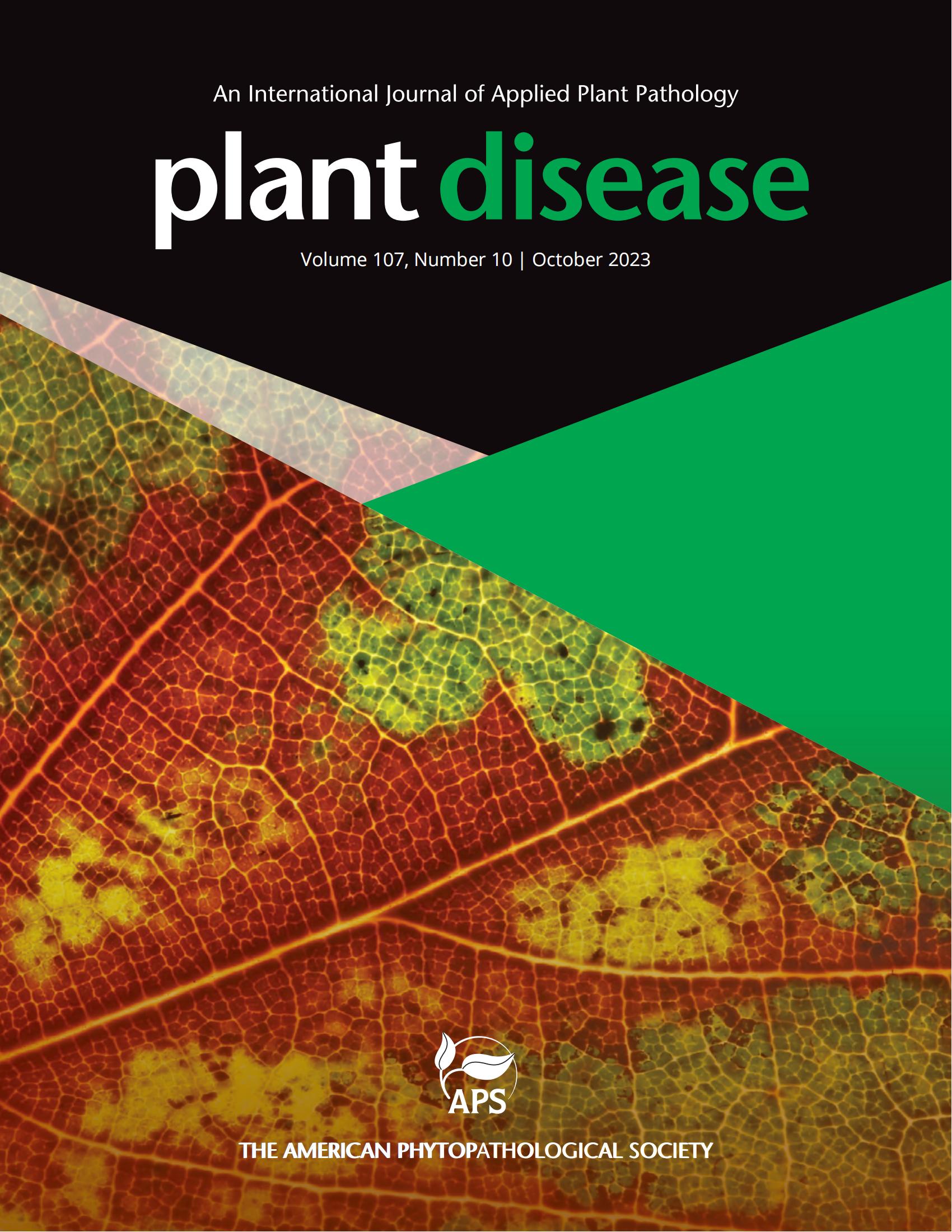中国首次报道由果胶杆菌菌株引起的马铃薯细菌性软腐病。
摘要
马铃薯(Solanum tuberosum L.)是全球重要的主粮作物,中国的产量占世界总产量的 20% 以上。在广东省,马铃薯已成为最重要的冬季作物之一,增加了农民收入。然而,近十年来,马铃薯受到由果胶杆菌引起的软腐病的严重影响。2024 年 2 月,广东省恩平市栽培品种 "大溪洋 "的植株上出现了典型的马铃薯软腐病症状,调查田块的发病率为 3%-5%。邻近试管的茎部出现典型的墨黑色症状,植株呈黄色。试管内部呈水渍状,整体腐烂,气味明显。收集了 11 株出现症状的植株,用于分离病原体。在有腐烂症状和无症状的边缘之间取下一小块试管组织(约 5×5 毫米),用 75% 的乙醇消毒 30 秒,再用 2% 的 NaClO 消毒 1 分钟。用无菌水冲洗 3 次,然后在 30°C 下在 Luria-Bertani(LB)培养基琼脂上培养 36 小时。选出产生的菌落在烟草上进行高敏试验,阳性反应的菌落再培养三次。对两个代表性菌株 EP51-2 和 EP51-3 进行了基因测序,包括看家基因、danX、leuS 和 recA(Portier 等,2019 年)。这两个代表性菌株的基因序列(GenBank登录号:PP870934 至 PP870939)与果胶杆菌菌株 NCPPB 929(CP166097.1)进行了比对,同一性为 97.15%至 100%,覆盖率为 100%。三个基因的序列被连接起来,与其他 19 种果胶杆菌的代表性菌株一起用于系统发育分析。系统进化分析结果表明,EP51-2 和 EP51-3 与代表菌株被归入 P. aroidearum。应用科赫推定来确定甲壳菌 EP51-2 株的致病性。根据马铃薯茎部外部接种法(Czajkowski 等人,2010 年),在六盆健康马铃薯植株的基部茎部各接种 100 µl 的细菌悬浮液(108 CFU/ml),六盆接种 LB 的植株作为对照。然后将植株放在 30°C 的温度下,保持 95% 的湿度。2 天后,接种了细菌的所有 6 盆植物的茎部都出现了典型症状,随后发展到整株植物倒伏;而对照组在观察期间一直没有出现症状。如上所述,使用 recA 引物进行 PCR 和测序,从接种植株有症状的茎上重新分离出的单菌落得到了确认,病原菌被确定为甲型肝炎嗜血杆菌菌株,符合科赫假说。在中国,大白菜(Xie 等,2018 年)和叶芥(Chu 等,2024 年)以及魔芋(Wei 等,2021 年)、芋头(Zhou 等,2022 年)和半夏(Du 等,2024 年)等天南星科作物上都曾报道过 P. aroidearum。据我们所知,这是 P. aroidearum 在中国引起马铃薯软腐病的首次报道。这种病原菌在广东省的芋头田里很普遍,造成了严重损失。本报告强调了该病原体寄主范围的扩大。应重点关注这种新出现的影响马铃薯的病原体,并立即采取措施控制其传播。Potato (Solanum tuberosum L.) is a globally important staple crop, and China has contributed more than 20% of the world's production. In Guangdong Province, potato has become one of the most important winter crops, increased the farmer income. However, the potato were seriously affected by soft rot disease caused by Pectobacterium spp. in the past decade. In February 2024, typical symptoms of potato soft rot were observed on the plants of cultivar "Daxiyang" in Enping City, Guangdong Province, where the disease incidences ranged 3%-5% in the investigated fields. The stems adjacent to the tubes showed typical inky black symptoms, and the plants appeared yellow. The interior of the tubes appeared water-soaked and had developed to overall decay, with an evident smell. Eleven symptomatic plants were collected and used to isolate the causal agents. Pieces of tube tissue (about 5×5 mm) were removed between the rot-symptomatic and non-symptomatic margins, and surface sterilized using 75% ethanol for 30 s and 2% NaClO for 1 min. The pieces were rinsed in sterile water for three times, and then plated on Luria-Bertani (LB) medium agar for 36 h at 30°C. The produced colonies were selected for hypersensitive test on tobacco, and the colonies with a positive reaction were subcultured three times. Two representative strains, EP51-2 and EP51-3, were processed for gene sequencing, including house-keeping genes, danX, leuS, and recA (Portier et al. 2019). The gene sequences (GenBank accessions no. PP870934 to PP870939) of these two representative strains were matched with Pectobacterium aroidearum strain NCPPB 929 (CP166097.1) with identities ranging from 97.15 to 100% and the coverage of 100%. The sequences of three genes were concatenated and used for phylogenetic analyses, along with representative strains from 19 other Pectobacterium species. Phylogenetic analyses supported that EP51-2 and EP51-3 were grouped into P. aroidearum with the representative strains. Koch's postulates were applied to determine the pathogenicity of P. aroidearum strain EP51-2. According to the external inoculation method on potato stems (Czajkowski et al. 2010), each of six pots of healthy potato plants was inoculated at the basal stem with 100 µl of bacterial suspension (108 CFU/ml), while six pots inoculated with LB served as controls. The plants were then kept at 30°C and maintained at 95% humidity. After 2 days, all six plants inoculated with the bacteria exhibited typical symptoms on the stems, which progressed to the collapse of the whole plant; the controls remained symptom-free during the observation. Single colonies reisolated from the symptomatic stem of the inoculated plants were confirmed using PCR and sequencing with recA primers as described above, and the causal agent was identified as P. aroidearum strains, fulfilling Koch's postulates. P. aroidearum has been reported on Chinese cabbage (Xie et al. 2018) and leaf mustard (Chu et al. 2024) in China, as well as on crops in the family Araceae, such as konjac (Wei et al. 2021), taro (Zhou et al. 2022), and Pinellia ternata (Du et al. 2024). To our knowledge, this is the first report of P. aroidearum causing potato soft rot in China. This pathogen has been prevalent in the taro fields in Guangdong Province and has caused severe losses. This report highlights an expansion of the host range for this pathogen. Attention should be focused on this newly emerging pathogen affecting potatoes, and immediate measures should be implemented to control its spread.

 求助内容:
求助内容: 应助结果提醒方式:
应助结果提醒方式:


